|
This page is about my fourth chicken flock (aka fourth generation) which I got in 2024. |

|
This page is about my fourth chicken flock (aka fourth generation) which I got in 2024. |

|
It was time to get new chickens. There were only two remaining from the previous flock, Olivia and Rosanne, and they were three years old. Rosanne is in henopause so she is no longer laying. Olivia, or "Miss Broody" as she is nicknamed, is a good winter layer but is typically broody in the warmer months so her egg production is not so great, but at least she still puts out from time to time.
Normally, we would have purchased chicks and raised them from ~three days old. But the whole home renovation really threw a monkey wrench in the whole process. Maybe we could have done it but we were both mentally and physically exhausted from the whole ordeal. In the previous flock, we introduced three pullets. That worked out great. We figured we'd try that again. But I had a hard time finding them. All the places I checked locally were sold out. So I went to the Maryland Poultry Swap on April 27, 2024 to see what I could find. For an extra five dollars, I could enter an hour early. Given the apparent demand for pullets, I decided that was the best option. I went in and found several others also purchasing pullets. With one vendor, it was like a game of "Pit" with so many people bugging him simultaneously to buy hens. I bought five from him, some up to a year old, paying $20 for each. 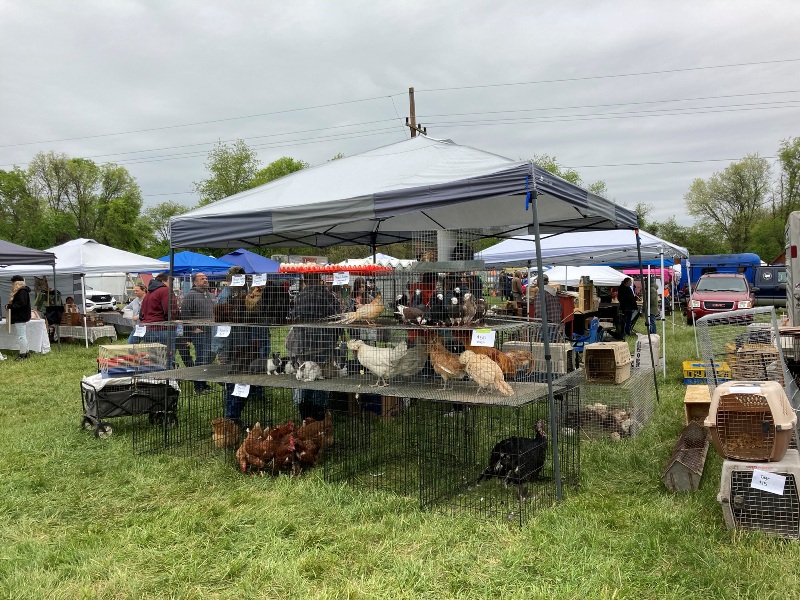
I boxed up the five chickens and then put them in my car. Making my way around the poultry swap, I met another vendor selling a breed I'd never heard of, Bielefelder. He told me the ones he had were just six weeks old. I was surprised at how big they were. He said they will grow very large. I purchased one hen from him for $15. It was still early and he was nearly sold out. 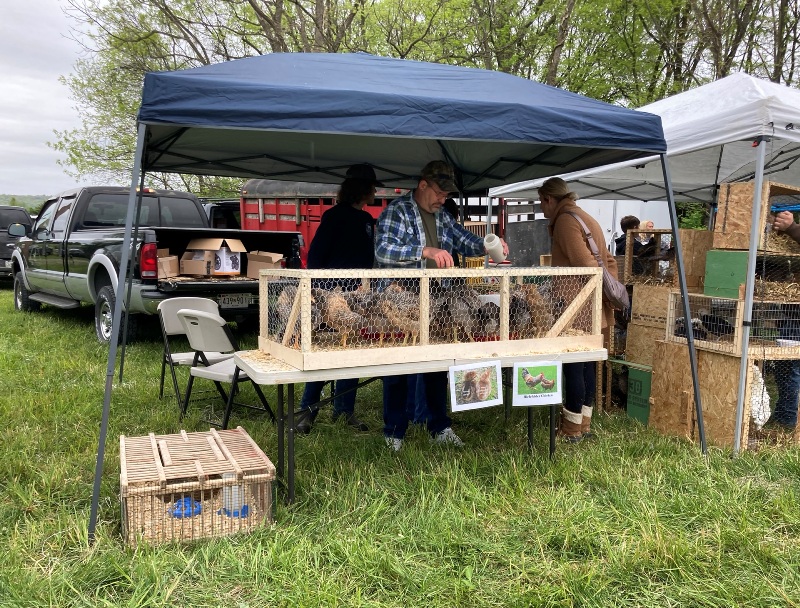
Just across from the Bielefelder tent was a fellow selling young Dark Brahmas and Barred Rocks. I think they were about eight weeks old. I purchased one of each from him for $10 each. 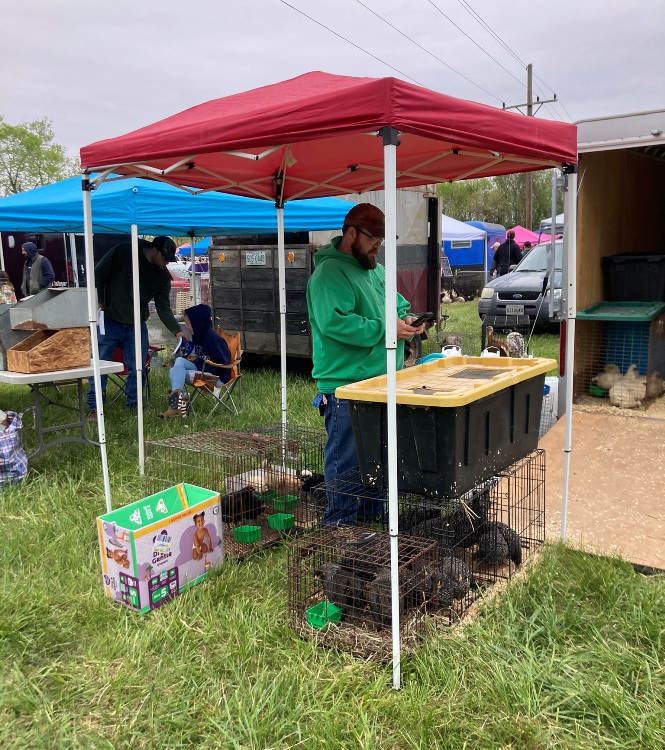
Given the amount of time, effort, and feed needed to raise chicks to pullets, I'm surprised these vendors were not charging more. This is definitely not a way I'd want to make a living given how little it pays. I felt quite successful purchasing eight pullets of all different breeds. I only wish they were closer in size. I knew it was going to be challenging to get them socialized. There will be fighting as they establish the pecking order. The two veterans, Oliva and Rosanne, will not be any help. I'll do what I can to ensure the fighting doesn't get too violent. I walked around the poultry swap and purchased freshly baked bread, jam, and other stuff before heading home.  |

|
Normally, I would put the new birds in the coop during the night. That is supposedly one way to make socialization easier. But it was still early and I didn't want to keep them in boxes. So I let the two veterans free range in the yard while the newbies were kept separate from them in the run.
As expected, the pullets were skeptical of their new environment. But once they got a little more confident, some fighting took place for the larger ones. The Buff Orpington is a bit of a troublemaker. Not so much for the Australorp. I think she is so big that nobody challenges her. Later that day, I had to let Olivia and Rosanne back in. Rosanne and the Buff Orpington fought quite a bit. I kept an eye on them and broke up the fight once someone clearly showed dominance...it was Rosanne. Rosanne is the biggest troublemaker of them all. I was wanting to pass her off but Norma was against it. She felt introducing a lone bird to a new flock was a bad way to thank Rosanne for her years of loyal service. I am now at ten birds which is two too many to be legal where I live. I figure if someone has to go, it should be Rosanne. For the first week, I've been letting the four largest birds (Olivia, Rosanne, Buff Orpington, and Australorp) free range during the day while the others stay in the run. I call those four the "jovians." We hope this will ease the socialization. At first, Olivia and Rosanne stayed on one side of the yard while Buff Orpington and Australorp stayed on the other. Eventually they started to integrate but I can tell there is bad blood between Rosanne and Buff Orpington. But at least the pecking order between the two has been established. In the top photo are the newbies in the run on April 28, 2024.  |

|
You may recall that much of the 2021 flock was decimated by predators. So in May 2024, I took extra care to prevent this from happening again.
I checked the perimeter and then installed an additional section of Dig Defence Large Animal Barrier to prevent predators from digging under our privacy fence. I purchased and installed nine HME Seal-Tite Drop Wick scent dispensers. I filled each with coyote urine to deter foxes. These containers are built to hold and dispense the scent of its contents while keeping rain out. 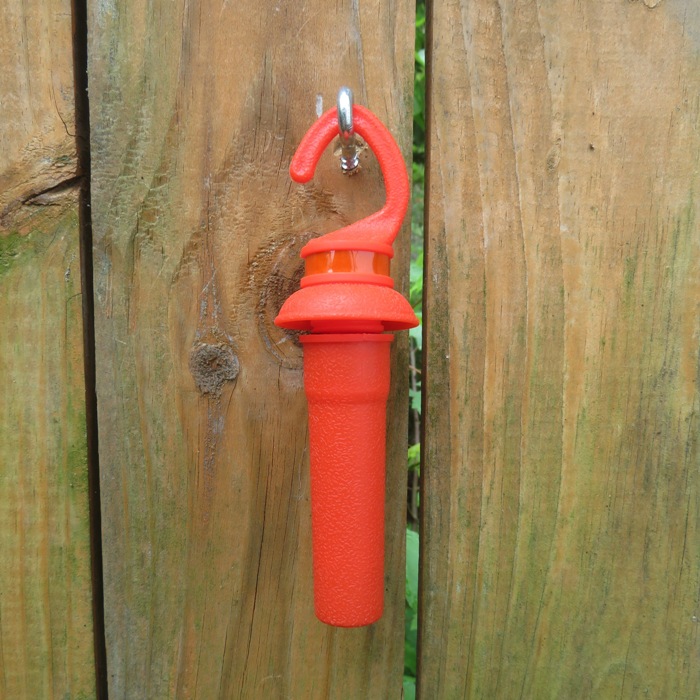
I put one at the southeast side of our fence. This is a narrow section along one of our garden planters where I have video footage of foxes (and Chester, our cat) hopping over the low fence. I also turned the top part of the fence into a "punji stake" trap by hammering several nails with the points facing upward. Immediately after doing so, I showed it to Chester. He's pretty smart so I believe he now avoids this route. 
I put two scent dispensers at the northeast side of our fence. Six were put at the west side of our fence which faces the park. Doing so, I found a four-foot long black rat snake on the fence between us and our north neighbor. It froze and appeared "kinked." I later read that "When frightened, they often assume a 'kinked' posture and remain motionless," noted the University of Georgia's Savannah River Ecology Laboratory. The posture makes it appear wrinkled. - from Tulsa World - Rat snakes sometimes freeze with "kinked" posture 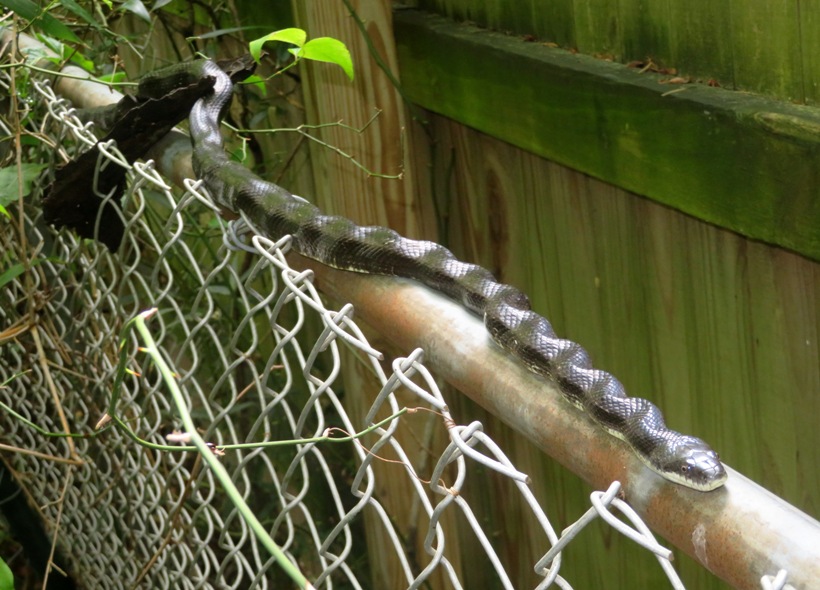
 |

|
Elisa is not my first Easter Egger chicken. This breed is advertised as being "friendly, great layers of large eggs in shades of blue and green." In my experience, they are not one of the more friendly, as compared to other breeds, but maybe I would think otherwise if I spent more time with them.
I've always wanted blue eggs but my Easter Eggers have always laid green. Based on Elisa's first egg color, her's are the greenest I have seen. 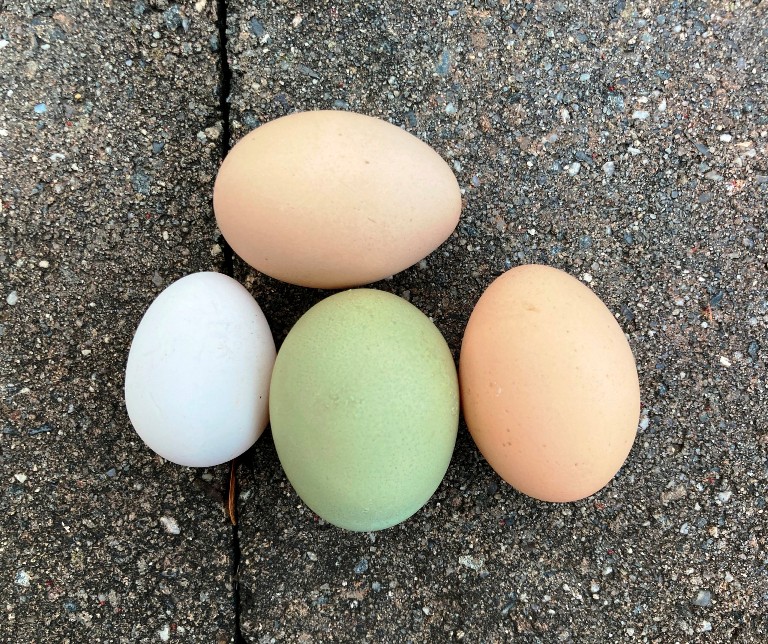
Easter Eggers are technically not recognized as a breed at all! They are more of a barnyard mix that has taken off. Easter Eggers are bred from an Araucana and a brown egg layer. Araucanas are known for their beautiful blue eggs. They have poofy cheeks and no tail feathers. They're a funny little chicken but can have a lethal gene that can kill chicks while in the shell. In order to combat this lethal gene, the Ameraucana chicken was bred. These chickens still contain the blue egg genes, but not the lethal gene that kills chicks. - from Strong Animals: All About the Easter Egger Breed I'm not so sure about the above statement. My Elisa has tail feathers and no poofy cheeks. If I want blue eggs, perhaps I should order Easter Eggers from a different hatchery. Different places make different claims about their so-called "breeds." The Genetic Selection for the Easter Eggers has been done through Centurion Poultry through the Vario-Ovo project. The Easter Eggers will produce 300-310 eggs in 52 weeks of lay. This cross has been selected for prolific laying and egg size. Productions of Blue Eggs will be around 85% while 15% will range in colors from a light cream to a light brown. The Father to the Easter Egger carries the Dominant Blue Gene while the mother is a Leghorn. The Leghorn Mother adds to the makeup of a hearty self-sufficient bird on the homestead while earning its keep with prolific laying and voracious foraging abilities. - from Freedom Ranger Hatchery: Easter Egger  |

|
I never judge the inside of an egg by the outside. Regardless of shell appearance, the taste and nutritional content is pretty much the same. Diet might change things like the omega-3 content, but the outer appearance of the shell is irrelevant. Still, some eggs are prettier than others. Beauty is purely subjective, but I expect if you did a survey, people would consider the following to be characteristics of a pretty egg:
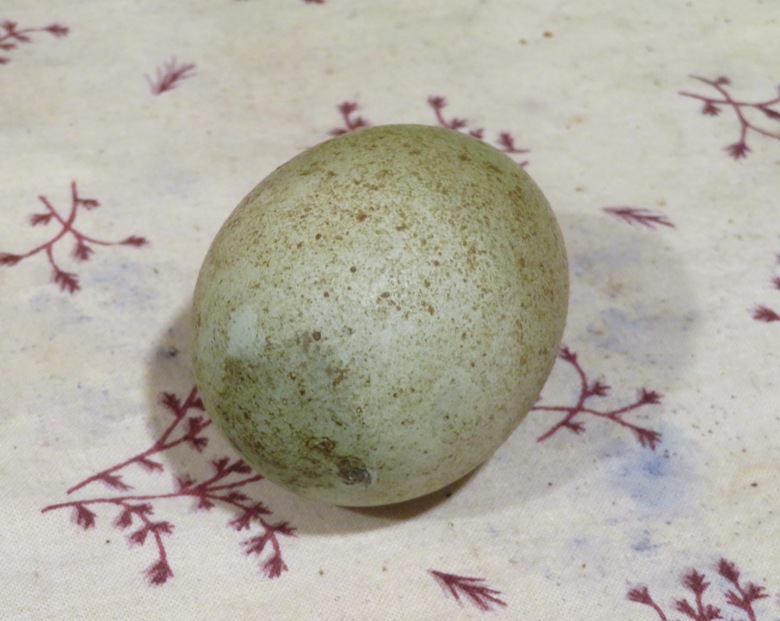
It looks dirty, even though it is clean. It is not an egg that I would sell, or even give away. I ate it myself and it was fine. The contents inside the shell looked the same as any other egg. Maybe there is some analogy here with people and not judging them by physical appearance, but rather by their character.  |

|
Who is the alpha?
Every flock has a dominant chicken. It takes awhile for hens to establish a pecking order, but once they do, the leader is deemed the "alpha." It works the same with humans, though what makes a dominant human is often more subjective. For us, it may be the smartest, strongest, most outgoing personality, or best in the skill we admire. With non-human animals, physical strength seems to be the primary factor, and that correlates strongly with size. So just by me looking at my flock, I can at least determine who is not the alpha, and who likely is. Alejandra is definitely my biggest chicken. I haven't really seen her fight with the others but I think her size intimidates the rest. The others simply avoid a confrontation with her. Fortunately, she does not abuse her power. 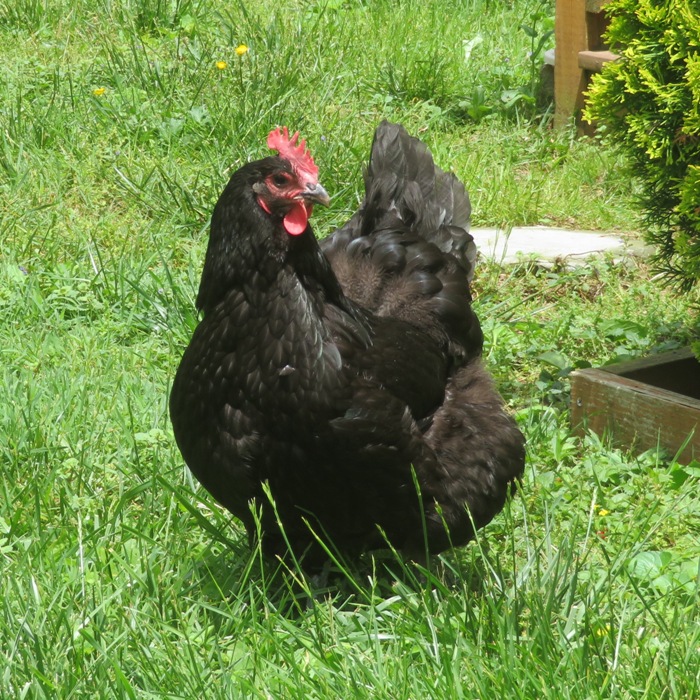
Rosanne, a red comet from my 2021 flock, is probably my most aggressive hen. She started fighting right away with Blanca, who was a similar size. But Rosanne is quick to peck at others that get too close. She has a chip on her shoulder and is quick to put weaker chickens in their place. Olivia, my olive egger from my 2021 flock, could be the alpha. She isn't as mean as Rosanne or as big as Alejandra, but she does exude a certain level of confidence and dominance. 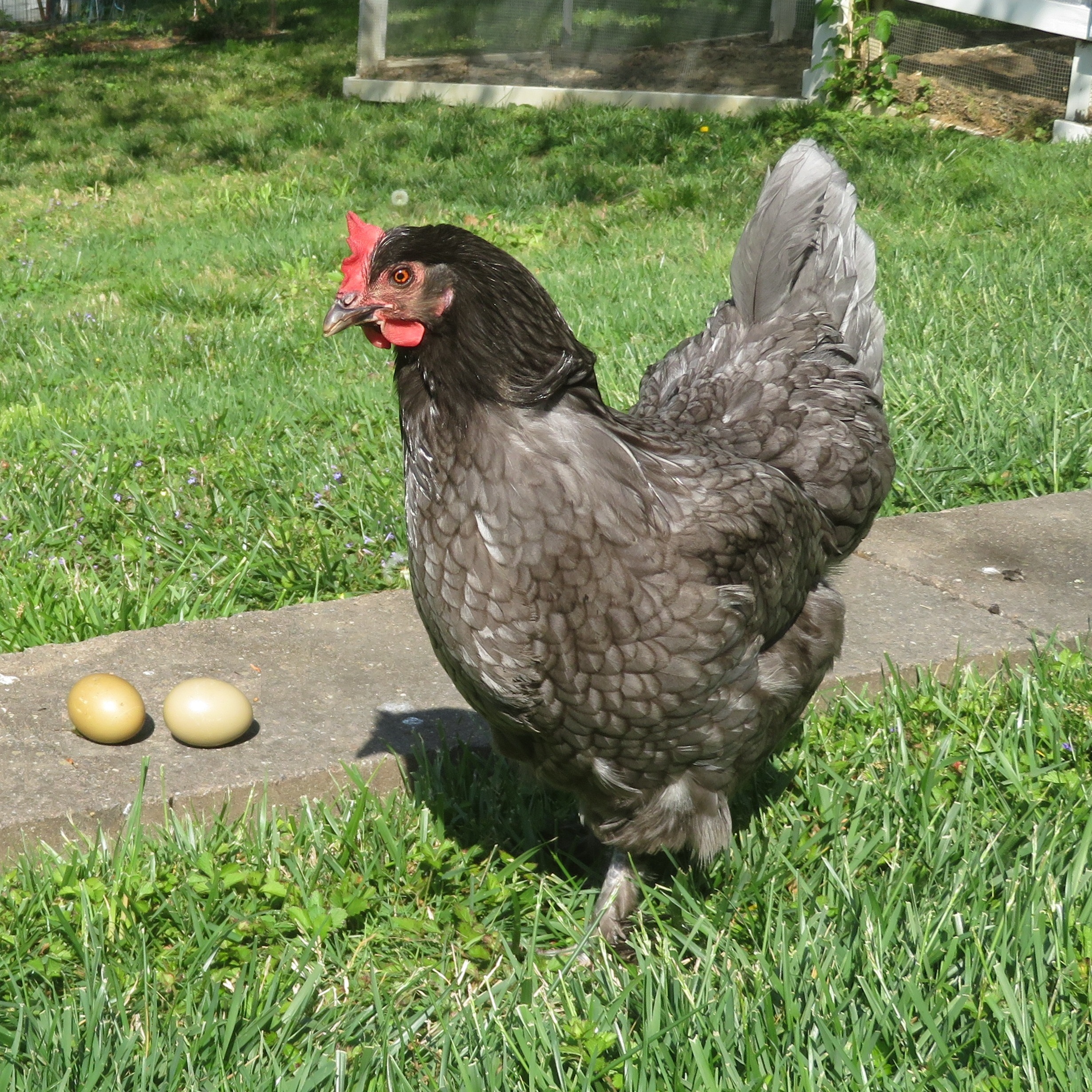
Blanca, a buff orpington, is also one of my largest chickens, but as I mentioned, Rosanne has proved that she is higher in the pecking order than Blanca. Hence, as of May 2024, I believe my alpha is Alejandra, Rosanne, or Olivia. Most of the other chickens are much smaller and most are not yet fully grown, so maybe the pecking order will shift in a few months. If that is the case, one of the smaller chickens that was bullied may get its payback. I mentioned that for humans, dominance is not necessarily determined by size. That's why it is important to be nice to everyone. Someone that is lower in the pecking order now might eventually become an alpha, and if that's the case, they will get their payback. The new hire in your office may someday become your boss.  |

|
From left to right in the below pic are Bonita, Bella, and Dolores. I call them the "Three Amigas" because they are almost always together.
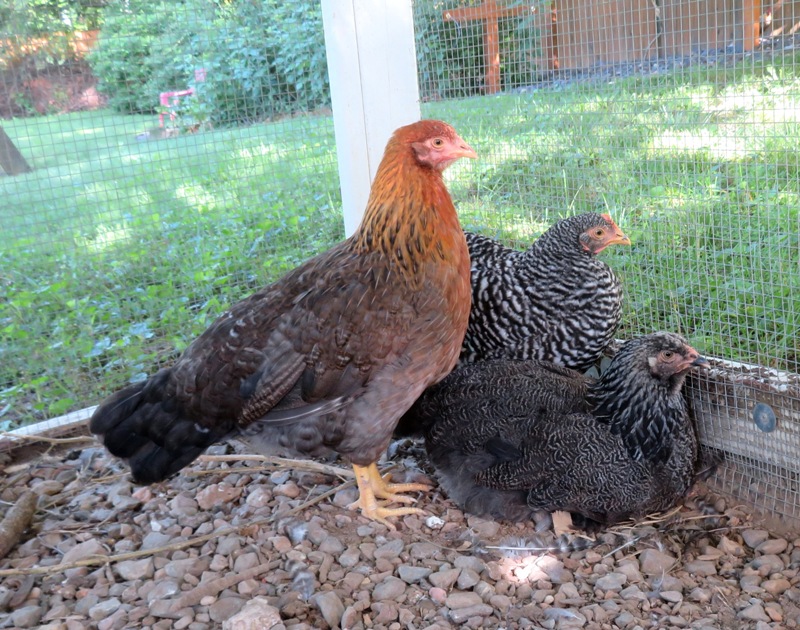
That's how it often works in life. You have your close group of friends that you bond with. It could be because of common interests, similar values, or the same goals. In the case of the Three Amigas, I think it is the latter. They are smaller than some of the other hens and their goal is to not get picked on. Sometimes people join gangs for the same reason. There is strength in numbers and their number is three. Eventually, the tide should turn and both Bonita and Dolores may get huge. If that occurs, one of them might become the new alpha. Hopefully, they will remember their friend, Bella, on their rise to the top.  |

|
For this flock, I have taken hundreds of snapshots. So one might think I'd have a lot of pics to show. But taking pictures of chickens is a lot like photographing wildlife...especially if the hens have not yet started laying. Once they start laying, they tend to be more docile. But until then, they often don't want me getting close. So I might not have as much to show as you think.
Here's Olivia and Gloria. I think Olivia looks very distinguished. Gloria just took a gulp of water. 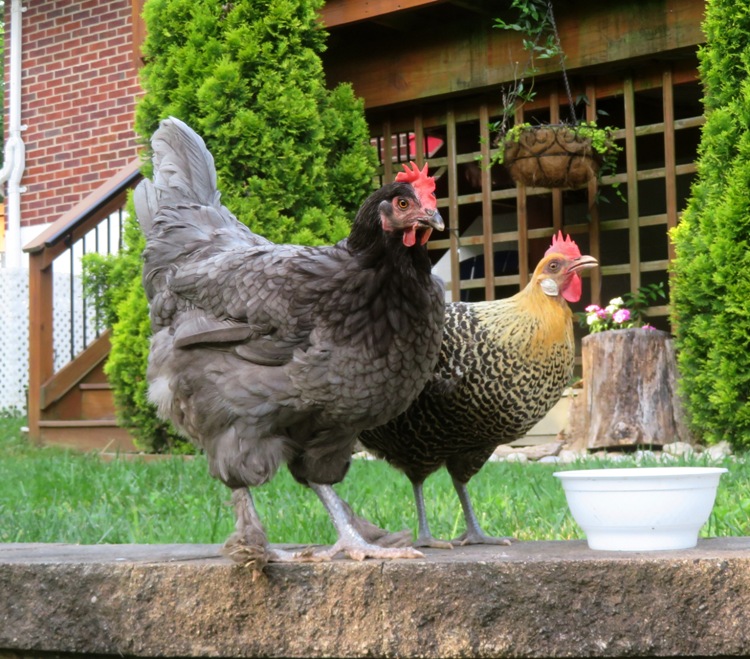
This is Carla and Alejandra. They are of two totally different breeds. I love the way their black feathers glisten in the bright sun. 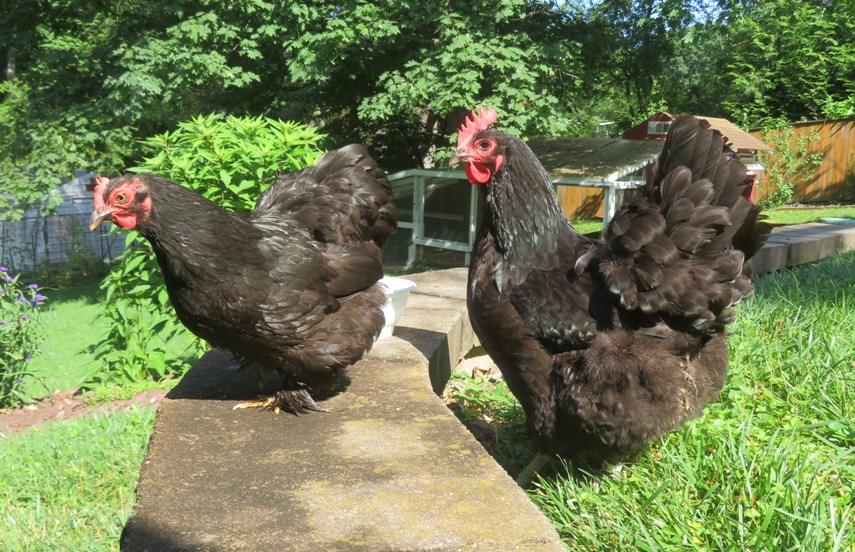
Shown here is Bella and Blanca. Bella is very camera shy and my camera doesn't like to focus on her barred feather pattern without bright light. 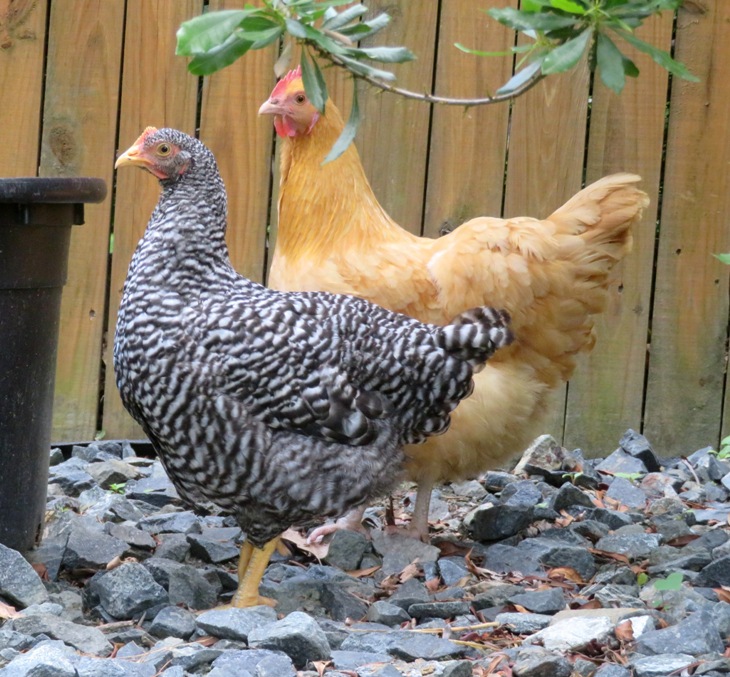
Here's Bonita and Bella. Bonita also doesn't like to pose for snapshots. I had to get the two of them in the coop. That's the only way I was able to get close to them. 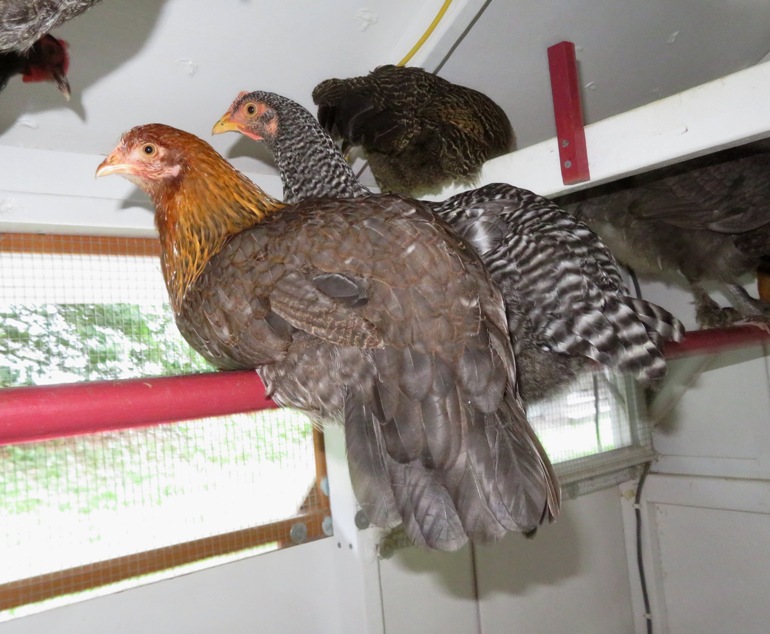
 |

|
Each flock of mine has a naming algorithm. The first rule is always to ensure the first letter of the name matches the first letter of the breed. For the first two flocks, the second rule was to have old-fashioned names. For the third, it was to be named after country music singers. For this flock, it is Hispanic names. I consulted with my Puerto Rican friend, Rey for suggestions.
AlejandraDate of birth: ~April 27, 2023Breed: Australorp Eggs/Year average: 250 [13] Description: Australorps are a popular producer of large brown eggs and are known for their hardiness and persistence in laying - even in hot weather. They can lay up to 250 eggs annually and will lay into winter. When this breed was being developed, the breeders focused on utility and still today this is what they are know for. Australorps are known to mature early and are docile and quiet birds, which makes them great for handling and children. When mature, the birds have glossy, all-black feathers that show a gorgeous green sheen. From the time these chicks hatch until they are fully grown, their feathers have white tips. Great dual-purpose choice. Average mature weight of hens: 6 pounds [21]. 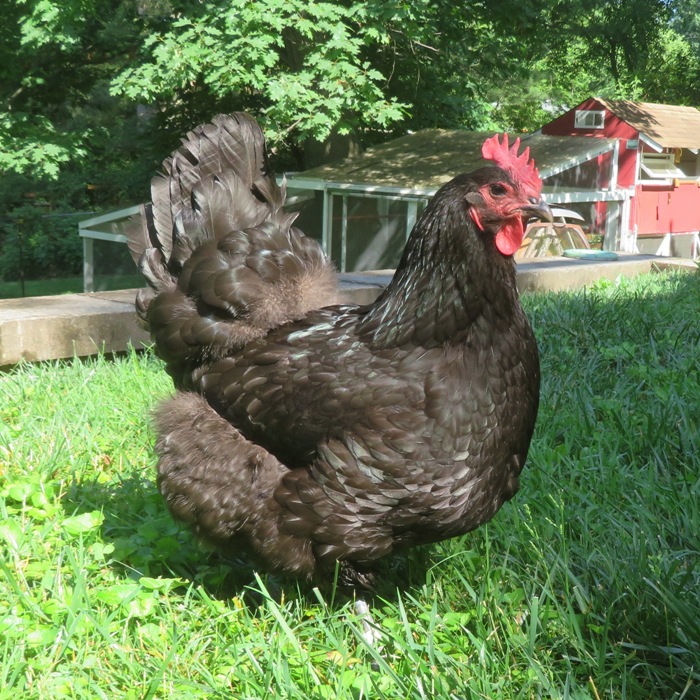
BellaDate of birth: ~March 9, 2024Breed: Barred Rock Eggs/Year average: 200 [13] Description: This old-time favorite lays brown eggs and is a popular dual-purpose breed. This breed is very friendly and does well in cold weather. Barred Rocks have high egg production, a meaty body, a docile personality, and good hardiness...all characteristics that would be a great addition to your flock! These lovely birds have black and white barred feathers, with the roosters slightly lighter in color than the hens. Average mature weight of hens: 6 pounds [21]. 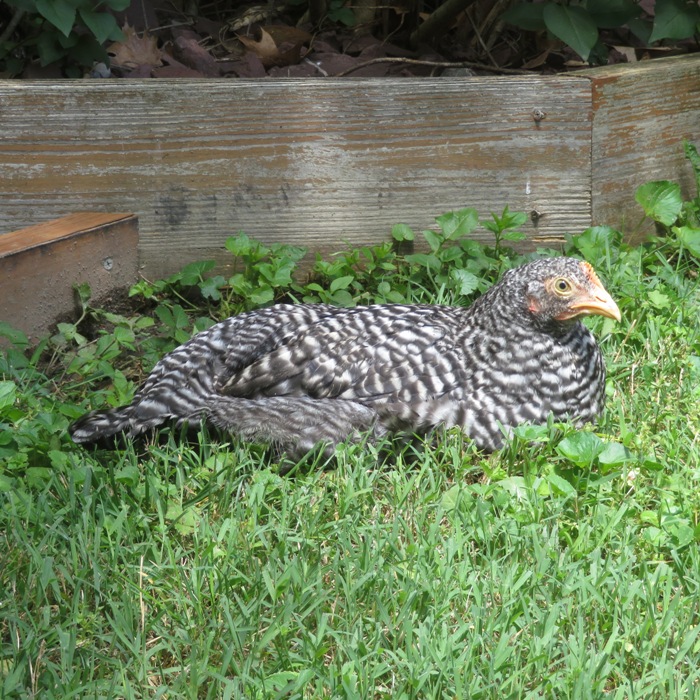
BlancaDate of birth: ~April 27, 2023Breed: Buff Orpington Eggs/Year average: 240 [33] Description: Buff Orpingtons are a popular dual-purpose variety and are sometimes called "Big Bufffs." This is a friendly and affectionate breed which would be good for children. Since they are so calm and quiet they can become bullied by an aggressive breed. Because they are loosely feathered, they appear to be heavier than their true weights. Their golden buff feathers are broad and smooth-fitting on this deep-bodied breed. They have quiet dispositions, make excellent mothers, and are one of the most broody of standard breeds. Their white skin is a cosmetic disadvantage for use as meat birds. Average mature weight of hens: 7 pounds [21]. 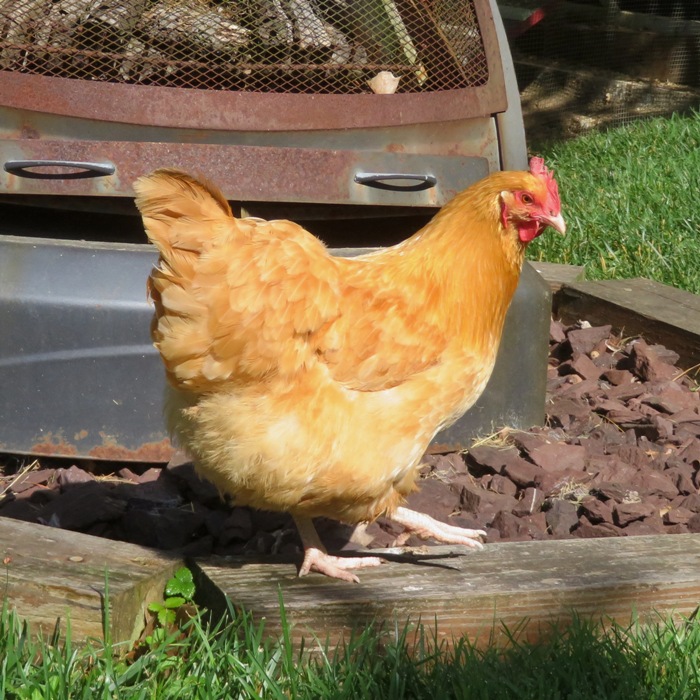
BonitaDate of birth: ~March 9, 2024Breed: Bielefelder Eggs/Year average: 230 brown eggs [69] Description: These chickens are a German rare breed of domestic chickens making a huge splash in the poultry world. It has gained the term "Uber Chicken" due to its many desirable characteristics such as being a dual-purpose bird and an easy-sexing breed. The Bielefelder has a large single comb, red earlobes, and wattles. A lot of people like the Bielefelder because of its auto-sexing ability, which means that the females and the males hatch in different colors. Bielefelder Chickens are good foragers, cold-resistant and quiet birds that are not very motivated to fly [69]. 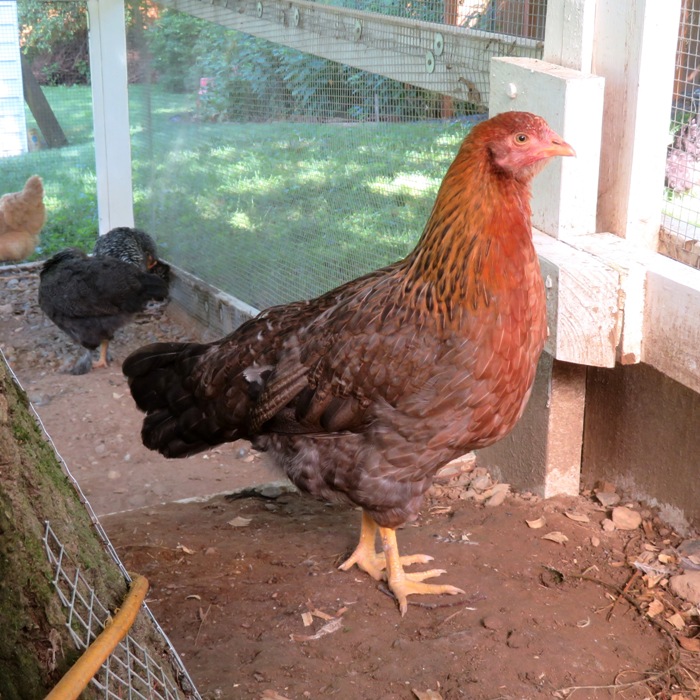
CarlaDate of birth: ~March 9, 2024Breed: Cochin Eggs/Year average: 100 brown eggs [69] Description: Asiatic, feather-footed breed covered with an extraordinary abundance of soft, fluffy colored feathers. The Black Cochin has a beautiful black feather pattern with a shiny iridescent green sheen making for a beautiful black bird from tip to toe. Extremely eye-catching. They have a bright red, single comb, along with red wattles, earlobes, and a red patch around the eyes [69]. When I purchased this chicken, I thought it was standard but after a few weeks, I came to realize it is a bantam. 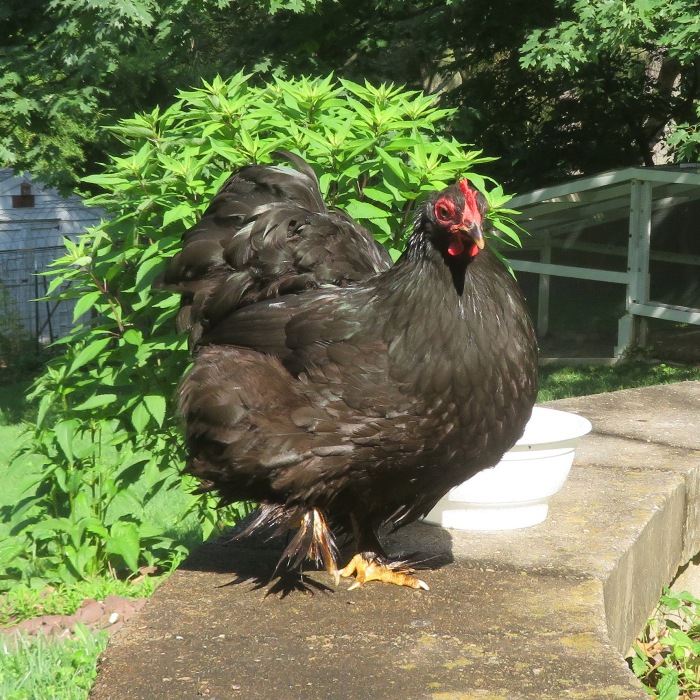
DoloresDate of birth: ~March 9, 2024Breed: Dark Brahma Eggs/Year average: Brown eggs laid mainly from October to May with an average of 3-5 per week [21] Description: Dark Brahma Chickens are known for their large size, feathered feet, and winter laying abilities. Introduced to the United States in the 1850's, these chickens helped to ignite a nationwide love for poultry. Brahmas are best suited for northern climates. Brahmas are slow to mature, make dedicated mothers, and are also excellent for roasting due to their very large size. Average mature weight of hens: 9.5 pounds [21]. 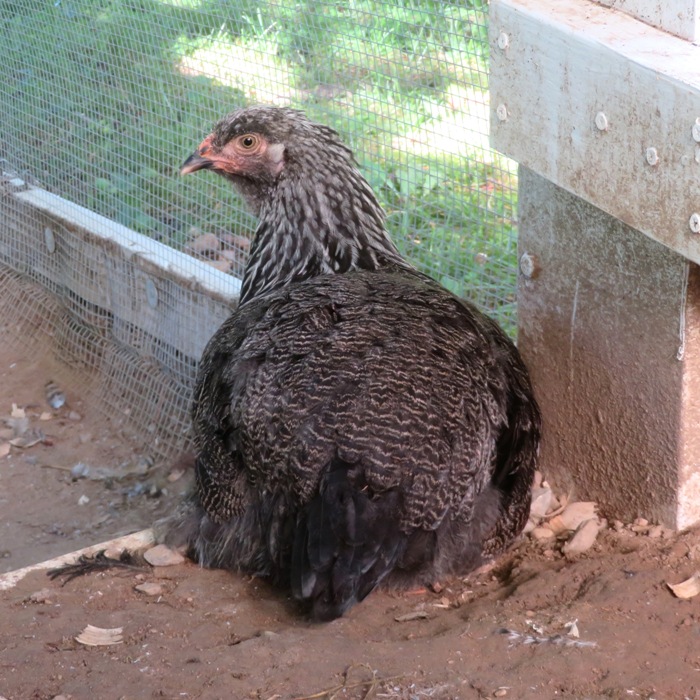
ElisaDate of birth: ~September 27, 2023Breed: Easter Egger Eggs/Year average: 240 [33] Description: Our most popular kid pick! Commonly known as the Easter Egg Layer, these birds are good layers and produce eggs that range from olive green to turquoise blue which their name comes from. Their small size allows them to do well in warm weather but they also do well in cold weather. Like their eggs, they come in an assortment of colors. They are favored for their eggs, but are large enough to be used for meat. Average mature weight of hens: 4 pounds [21]. This breed has an inherent genetic beak issue. 1 out of 100 chicks as they grow may have some variance in severity of scissor beak/cross beak. This can be best described when the top and bottom beak do not align and this condition normally will get worse as they grow [33]. 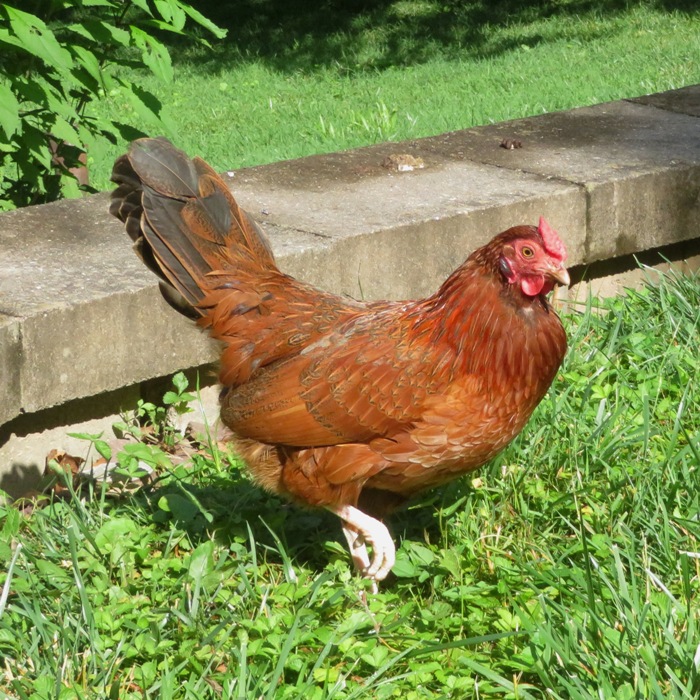
GloriaDate of birth: ~September 27, 2023Breed: Golden Campine Eggs/Year average: 150-200 [34] Description: Beautiful birds that lay around three or more large white eggs per week. The Campine originated in Belgium. They are alert birds with close-fitting feathers, white skin color, white earlobes, and grayish-blue legs. They are super active and foraging is their specialty. They were bred primarily as layers and do not tend to sit on their eggs. Golden Campine Chickens have black and reddish-gold barring on their body and tail, with a solid reddish-gold head and neck. Average mature weight of hens: 4 pounds [21]. 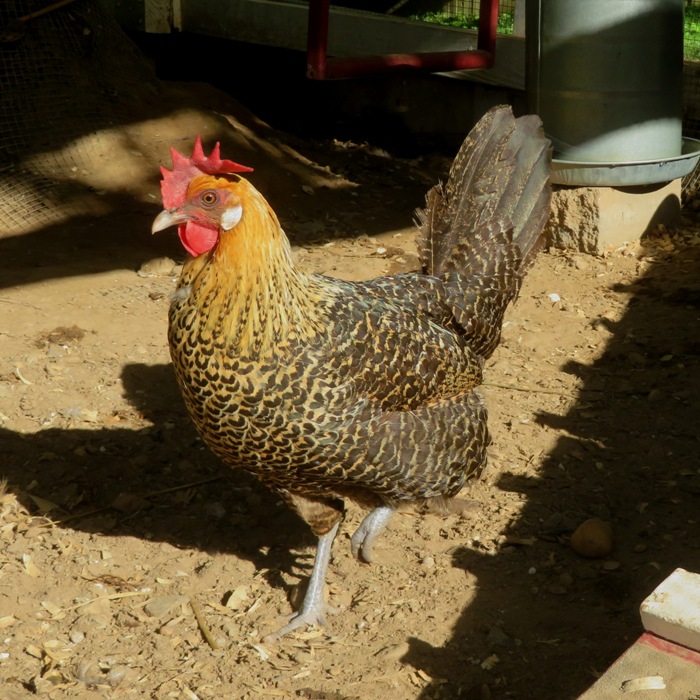
 |

|
No, I didn't bring a chicken to work. But I did the next best thing.
A few years ago, my office held a cat contest. I didn't nominate Chester but I should have. The next year, they had a dog contest. I nominated Daphne and she won. Two years after that, they held a contest for pets that were not dogs or cats. I nominated Olivia. Here is the corporate description and photo I submitted in April 2024: Olivia, an Olive Egger chicken, was named after country music singer Olivia Rose. She lays very dark brown eggs that have almost a milk chocolate look. We've nicknamed her "Miss Broody" because she often goes broody when the weather is warm. A broody hen thinks she is going to hatch chicks. Her body temperature rises to incubate the eggs, and she sits on them day and night, only getting up to eat, drink, and poop. A broody hen also quits laying eggs. This means she doesn't have the best egg production. However, Olivia is a good winter layer which most hens are not. Hence, she has an important skill, making her a valuable member of a diverse team, just like we have in our organization. Olivia arrived with eight other chicks when they were about three days old. Unfortunately, due to predators, she is the last survivor. But as of recently, several pullets (female adolescent chickens) have arrived so she will have the opportunity to practice her mentoring skills to bring the others up to speed. 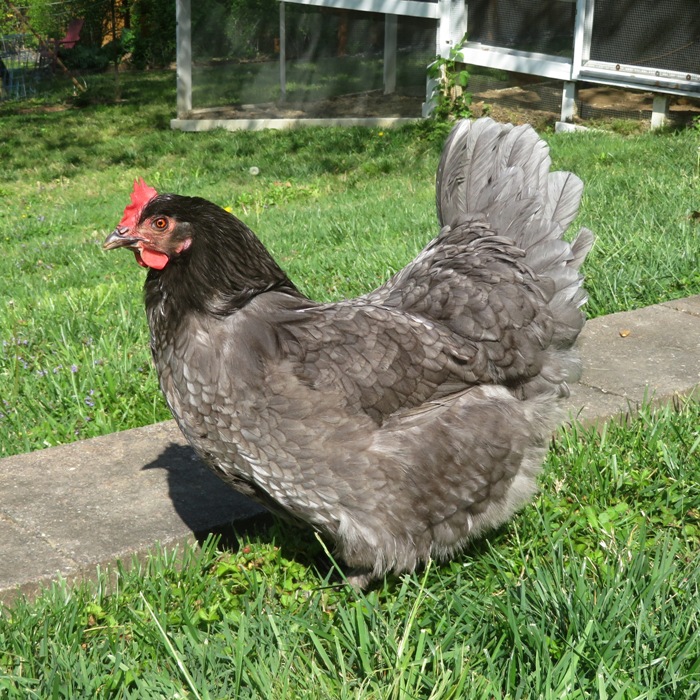
Olivia won!  |

|
Early on August 20, 2024, Norma saw a fox around the coop. Either it hopped over the fence along the north or south sides, or it ignored the scent of the coyote urine which I put out to deter foxes. Either way, that was not good. The next day, I sprayed coyote urine around the coop itself and put the girls on lockdown for a few days.
The next morning, Olivia was dead at the feeder. There were no signs of trauma. She was three years and four months old. I am attributing her death to natural causes. I loved the dark brown eggs she provided. They almost looked like chocolate because they were so dark. She was not a good layer because she was broody so often. But she was a good winter layer so she provided us with eggs when the others did not. Compared with the others, I felt she was the prettiest and that's why I nominated her for office pet. She died holding that title. Fortunately, I was able to get plenty of good photos of her before she passed. Olivia will be missed. 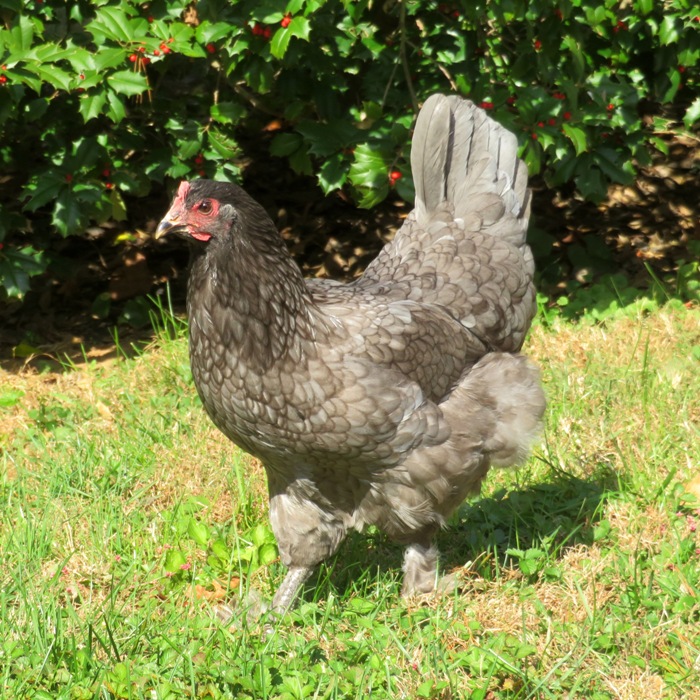
 |

|
Of all the eggs my chickens have laid, I think Elisa's green egg was the most beautiful. Unfortunately, I only ever received one egg from her. She never got very big and eventually, she started losing weight. By the time we took notice, it was too late. She was in the nesting box for the night. I just figured she was broody. But Norma was concerned and took a closer look. She was lethargic. Looking down her throat, Norma saw a large, yellow growth. It was likely canker. We tried to remove as much as possible with tweezers and a small crochet needle.
Then Norma ordered some medicine. I don't know how effective it would have been. A few years ago, it became illegal to obtain veterinary antibiotics unless prescribed by a veterinarian. I suspect this has something to do with their possible overuse and the subsequent growth of antibiotic-resistant bacteria. We isolated Elisa and fed her liquid food (egg) and water via a syringe. But within two days, she was dead...before the medicine arrived. She passed on October 10, 2024. She was just over a year old.  |

|
On November 6, 2024, Gloria did not come into the coop after free-ranging during the day. The next morning, Norma found that she was killed by a hawk. I have disco balls out to prevent raptors away but it was a cloudy day when she died.
Gloria was one of my smaller hens so she would have been an easy target for a hawk. Down to seven.  |